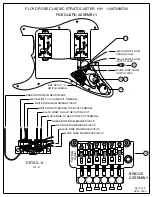
14.
The slippery treble strings require a bit more care to
keep them tight, but the technique is substantially the same.
You can insert the string either way through the holes in the
bridge. The high-E (treble) string has an additional loop to
avoid slippage. Begin by looping the string under itself.
11.
Loop the free end of the A string over the untrimmed end
of the low-E string to hold it neatly in position.
12.
Loop the free end under the string just behind the
saddle and pull it back toward the end of the guitar, creating a
bend in the string, as in Step 3.
13.
Snip the excess from the 6th (E) string, making sure the
remainder of the string is a little shorter than the distance to
the next hole. Next, put on the 4th (D) string, using the same
method as with the 6th and 5th strings.
9.
Tighten the string, winding it toward the outside of the
rollers, over the tail of the string. Guide the string so that it is
neatly coiled and doesn’t rub on the edges of the peghead. Tune
to pitch. For best tuning, use a maximum of 4-6 wraps, and then
snip the excess string end.
10.
Pull the A (5th) string into position.
8.
Hold a little tension on the string with your upright right
fist (to create the correct amount of slack) as you pull the loop
tight against the roller with your left hand. The bend should be
in the top of the tuner hole to lock the string in position.
7.
Loop the free end of the string up and around the top of
the tuner roller and pass it under itself.







